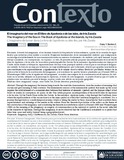El imaginario del mar en El libro de Apolonia o de las islas, de Iris Zavala

Ver/
Fecha
2019Autor
Palabras Clave
Imaginario, Cuerpo, Mar Caribe, Iris Zavala, Literatura puertorriqueñaImaginary, Body, Caribbean sea, Iris Zavala, Puerto Rican literature, Littérature portoricaine
Imaginaire, Corps, Mer des Caraïbes, Iris Zavala, Littérature portoricaine
Metadatos
Mostrar el registro completo del ítemResumen
A través del imaginario, el ser humano transita la búsqueda de la trascendencia, a partir de la creación de significados
que sustentan y dan sentido a su existir. El ejercicio hermenéutico de los innumerables símbolos que configuran lo
social exige el establecimiento de una comunicación entre ese universo de elementos, de símbolos y el sujeto humano, lo que
dibuja su realidad, sus concepciones, sus espacios, su vida. El presente artículo propone una interpretación de la novela El
libro de Apolonia o de las islas, de la escritora puertorriqueña Iris Zavala. En la narración, Apolonia realiza un viaje por el
Caribe, desde donde se dibujan las representaciones del mar como principal símbolo sobre el que se constituye el imaginario
caribeño. Se trata de un viaje por la historia, un viaje multitemporal, que va llevando al lector por aquellas características
que constituyen estas representaciones y significaciones de lo marino en esta cultura. Desde los postulados teóricos de la
autora sobre el tema de la construcción del imaginario, y al considerar los aportes teóricos planteados por Durand (2000) y
Wunenburger (2008) sobre el significado del imaginario, se realiza una exégesis de la comunicación en el universo de símbolos
en la novela, reflejado en el personaje de Apolonia. A través de este imaginario, se puede observar que el Caribe se
plantea como un símbolo que reviste tiempo, espacio y ente, más allá de ser un punto geográfico.
Colecciones
Información Adicional
| Otros Títulos | The Imaginary of the Sea in The Book of Apollonia or the Islands, by Iris Zavala - L’imaginaire de la mer dans Le livre de l’apollonie ou des îles, par Iris Zavala |
| Correo Electrónico | dbeniteszambrano@gmail.com |
| Editor | SaberULA |
| ISSN | 1315-9435 |
| ISSN Electrónico | 2610-7902 |
| Resumen en otro Idioma | Through the imaginary, the human being transits the search for transcendence, from the creation of meanings that
sustain and give meaning to their existence. The hermeneutic exercise of the innumerable symbols that make up the social
requires the establishment of a communication between that universe of elements, symbols and the human subject, what
draws its reality, its conceptions, its spaces, its life. This article proposes an interpretation of the novel El libro de Apolonia
o de las islas, by the Puerto Rican writer Iris Zavala. In the narration, Apolonia makes a trip through the Caribbean, from
where the representations of the sea are drawn as the main symbol on which the Caribbean imaginary is constituted. It is a
journey through history, a multi-temporal journey, which is taking the reader by those characteristics that constitute these
representations and meanings of the marine in this culture. From the theoretical postulates of the author on the theme of
the construction of the imaginary, and considering the theoretical contributions raised by Durand (2000) and Wunenburger
(2008) on the meaning of the imaginary, an exegesis of communication in the universe of symbols in the novel, reflected
in the character of Apolonia. Through this imaginary, it can be observed that the Caribbean is considered as a symbol that
takes time, space and entity, beyond being a geographical point. - À travers l’imaginaire, l’être humain passe par la recherche de la transcendance, de la création de significations qui maintiennent et donnent un sens à leur existence. L’exercice herméneutique des innombrables symboles qui configurent le social nécessite la mise en place d’une communication entre cet univers d’éléments, de symboles et le sujet humain, ce qui en tire sa réalité, ses conceptions, ses espaces, sa vie. Cet article propose une interprétation du roman El libro de Apolonia o de las islas, de l’écrivain portoricain Iris Zavala. Dans la narration, Apolonia fait un voyage à travers les Caraïbes, d’où les représentations de la mer sont dessinées comme le principal symbole sur lequel se constitue l’imaginaire des Caraïbes. C’est un voyage à travers l’histoire, un voyage multi-temporel, qui amène le lecteur à comprendre les caractéristiques qui constituent ces représentations et significations du marin dans cette culture. À partir des postulats théoriques de l’auteur sur le thème de la construction de l’imaginaire, et compte tenu des contributions théoriques soulevées par Durand (2000) et Wunenburger (2008) sur le sens de l’imaginaire, une exégèse de la communication dans l’univers de symboles dans le roman, se reflète dans le personnage d’Apolonia. À travers cet imaginaire, on peut constater que les Caraïbes sont considérées comme un symbole qui prend du temps, de l’espace et de l’entité, au-delà d’être un point géographique. |
| Colación | 85-95 |
| Periodicidad | Anual |
| País | Venezuela |
| Institución | Universidad de Los Andes (ULA) |
| Publicación Electrónica | Contexto |
| Sección | Revista Contexto: Artículos |





